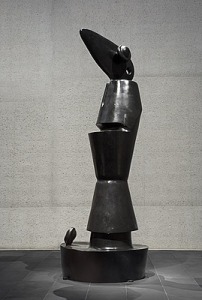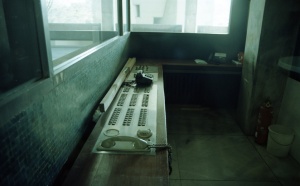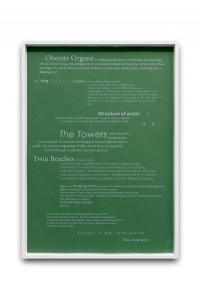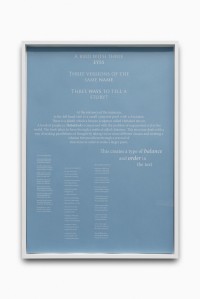 When Max Ernst was six years old his beloved pink cockatoo Hornebom died on the same day that his youngest sister was born. Max Ernst believed his fascination for birds came from this early event. He described his “feeling of nothingness” and also during a bout of measles experienced hallucinations of “a menacing nightingale” that was to recur throughout his work.
When Max Ernst was six years old his beloved pink cockatoo Hornebom died on the same day that his youngest sister was born. Max Ernst believed his fascination for birds came from this early event. He described his “feeling of nothingness” and also during a bout of measles experienced hallucinations of “a menacing nightingale” that was to recur throughout his work.
 His sculpture Habakuk, constructed from casts of awkwardly stacked flowerpots, is a bug-eyed and beaky totem pole. The sculpture has a third eye, a supposed comment on artist as visionary or prophet, which is foregrounded by its being named after Habakkuk, one of the junior prophets in the Hebrew Bible.
His sculpture Habakuk, constructed from casts of awkwardly stacked flowerpots, is a bug-eyed and beaky totem pole. The sculpture has a third eye, a supposed comment on artist as visionary or prophet, which is foregrounded by its being named after Habakkuk, one of the junior prophets in the Hebrew Bible.
Habakkuk condemned the makers of idols, that is, sculptors: “What profiteth the graven image that the maker thereof hath graven it; the molten image, and a teacher of lies, that the maker of his work trusteth therein, to make dumb idols?” Thus by naming it after the prophet Habakkuk, Ernst’s sculpture ‘Habakuk’ is in a sense a response to Biblical art criticism.
Habakuk appears repeatedly in Charlotte Moth’s installation ‘The Story of a Different Thought’. She describes the body of work as existing through three mediums – film, silkscreens, sculpture. Across these there are three aesthetics – mythic, essayist, diagrammatic.
 A BIRD WITH THREE EYES
A BIRD WITH THREE EYES
THREE VERSIONS OF THE SAME NAME
THREE WAYS TO TELL A STORY?
Leonardo’s Prophecy “The Shadow” is quoted as a frontispiece to the film treatment: “Many a time will one man be seen as three and all three move together, and often the most real one quits him (of our shadow cast by the sun, and our reflection in the water at one and the same time).”
Let’s take the three main elements of the show one at a time.
The film “The Story of a Different Thought” uses voiceover and a mixture of visual techniques to explore three different spaces The Rathaus Marl, Twin Beaches, and Oberste Organe and how these buildings represent Flotation and Suspension.
 The Rathaus Marl is a ‘suspended tower’ you can think of like a reinforced concrete mushroom from the top down with office floors hung doiwn from the building core. It was completed in 1964 as a new expression of identity for the town of Marl, which had grown wealthy in the 1920s for chemical engineering and coal mines, but following the war initiated a change in infrastructure, with the centralisation of the town and the creation of this new town hall, which was conceived so it could in principle serve as a building core that could be expanded on. However, the fortunes of the town deteriorated, as did the materials used to construct the building. In the 1980s the towers had to be reinforced, at great expense to a town down on its fortunes.
The Rathaus Marl is a ‘suspended tower’ you can think of like a reinforced concrete mushroom from the top down with office floors hung doiwn from the building core. It was completed in 1964 as a new expression of identity for the town of Marl, which had grown wealthy in the 1920s for chemical engineering and coal mines, but following the war initiated a change in infrastructure, with the centralisation of the town and the creation of this new town hall, which was conceived so it could in principle serve as a building core that could be expanded on. However, the fortunes of the town deteriorated, as did the materials used to construct the building. In the 1980s the towers had to be reinforced, at great expense to a town down on its fortunes.
 Twin Beaches is an unfinished house on Lake Manatoba, the world’s third largest glacial lake, which can fall to temperatures of minus fifty — colder than Mars. On the shoreline a small experimental architecture firm called DIN Projects has constructed a building which has floors that can rise when the water level rises. This means you could call it cybernetic, in that it responds and adjusts according to stimuli that it monitors and feeds back in. Oberste Organe is a civic building with essentially a floating roof which is also cybernetically managed by a mysterious “ring balance equation”.
Twin Beaches is an unfinished house on Lake Manatoba, the world’s third largest glacial lake, which can fall to temperatures of minus fifty — colder than Mars. On the shoreline a small experimental architecture firm called DIN Projects has constructed a building which has floors that can rise when the water level rises. This means you could call it cybernetic, in that it responds and adjusts according to stimuli that it monitors and feeds back in. Oberste Organe is a civic building with essentially a floating roof which is also cybernetically managed by a mysterious “ring balance equation”.
 Cybernetic architecture sounds rather science fiction but it has been around for a while. Bridges are constructed with certain gaps to allow for expansion in hot/cold weather. Earthquake proof buildings flexible, they are in a sense less rigid than conventional buildings so they can shift when the earth does. The concepts of stability and flexibility are interlinked: to be strong, a building must give way. The three structures the film presents all express suspension and flotation whether in a cybernetic way as here or in a more monolithically modernist way as in the Rathaus Marl.
Cybernetic architecture sounds rather science fiction but it has been around for a while. Bridges are constructed with certain gaps to allow for expansion in hot/cold weather. Earthquake proof buildings flexible, they are in a sense less rigid than conventional buildings so they can shift when the earth does. The concepts of stability and flexibility are interlinked: to be strong, a building must give way. The three structures the film presents all express suspension and flotation whether in a cybernetic way as here or in a more monolithically modernist way as in the Rathaus Marl.
The film also shows us Donatello’s statue of Habakkuk, which is part of the Santa Maria Cathedral in Florence, another building which is seen as a landmark of Renaissance architecture for its “rhythmic, geometric unity” ie. balance, which is another configuration of flotation/suspension. We also also see footage from Florence of workers marbling paper, a process employing flotation and suspension.
 The second element of the show is five large silkscreens that present different outlines and formations of the themes, beautiful Renaissance concepts and other demonstrations of ideas, physical locations, the story of Habakuk and its inspiration in Max Ernst’s life. The silkscreens chart links between the various configurations of Habakuk – Ernst’s sculpture, Donatello’s, the prophet Habakkuk, and also our third variant spelling Habbakuk, which was an ice warship from the Second World War used as an emergency landing platforms in the Atlantic. In those days sophisticated computer modelling hadn’t been invented so testing would involve going somewhere and blowing shit up, and the place where this technology was tested happened to be Lake Patricia right next to Lake Manatoba, adding another connection between Habakuk and flotation/suspension and the buildings.
The second element of the show is five large silkscreens that present different outlines and formations of the themes, beautiful Renaissance concepts and other demonstrations of ideas, physical locations, the story of Habakuk and its inspiration in Max Ernst’s life. The silkscreens chart links between the various configurations of Habakuk – Ernst’s sculpture, Donatello’s, the prophet Habakkuk, and also our third variant spelling Habbakuk, which was an ice warship from the Second World War used as an emergency landing platforms in the Atlantic. In those days sophisticated computer modelling hadn’t been invented so testing would involve going somewhere and blowing shit up, and the place where this technology was tested happened to be Lake Patricia right next to Lake Manatoba, adding another connection between Habakuk and flotation/suspension and the buildings.
 The third element of the show is the sculptures. These “maquettes” are not conceived in relation to any one space, are the hardest to understand in the context of everything else. They’re these little open boxes on stilts, one with sort of disappointed candles without strings. Moth seems to intend them to be “experiential” ie. that you explore them as you do spaces in buildings. They don’t present a structured view or narrative in themselves but allow another approach to the themes. In her fig-2 interview Moth explains “Not everything can be said through a film or through a photograph or just one way of seeing.”
The third element of the show is the sculptures. These “maquettes” are not conceived in relation to any one space, are the hardest to understand in the context of everything else. They’re these little open boxes on stilts, one with sort of disappointed candles without strings. Moth seems to intend them to be “experiential” ie. that you explore them as you do spaces in buildings. They don’t present a structured view or narrative in themselves but allow another approach to the themes. In her fig-2 interview Moth explains “Not everything can be said through a film or through a photograph or just one way of seeing.”
In considering notions of suspension and flotation we are exploring balance, and another way the show explores this is via Habakkuk and the notion of chiasmus.
 In rhetoric, the classic example of chiasmus is Kennedy’s “Ask not what your country can do for you, ask what you can do for your country.” Chiasmus can be represented as an ‘x’ structure of four points, one for each topic, wherein the top left topic is repeated as the last, and the other two repeat to form the ‘AB-BA’ structure (country, you, you, country). This criss-cross structure existed in the ancient world but was especially appealing later to Christians, though perhaps not so much for the ‘cross’ structure (which might be me labouring it) but because of the articulation of the balance of order within the structure of text itself.
In rhetoric, the classic example of chiasmus is Kennedy’s “Ask not what your country can do for you, ask what you can do for your country.” Chiasmus can be represented as an ‘x’ structure of four points, one for each topic, wherein the top left topic is repeated as the last, and the other two repeat to form the ‘AB-BA’ structure (country, you, you, country). This criss-cross structure existed in the ancient world but was especially appealing later to Christians, though perhaps not so much for the ‘cross’ structure (which might be me labouring it) but because of the articulation of the balance of order within the structure of text itself.
 Rhetorical chiasmus is found extensively in Milton and (less obviously) in Shakespeare, and in the Greek and Hebrew texts of the Bible and throughout the Book of Mormon. Habakkuk’s book of prophecy is said to have a chiastic structure “in which parallelism of thought is used to bracket sections of the text.” It’s not that words and phrases repeat, but that the whole structure on a higher level of motifs, turns of phrase, or passages, employs chiasmus.
Rhetorical chiasmus is found extensively in Milton and (less obviously) in Shakespeare, and in the Greek and Hebrew texts of the Bible and throughout the Book of Mormon. Habakkuk’s book of prophecy is said to have a chiastic structure “in which parallelism of thought is used to bracket sections of the text.” It’s not that words and phrases repeat, but that the whole structure on a higher level of motifs, turns of phrase, or passages, employs chiasmus.
In examples like Kennedy’s statement chiasmus creates two sides of an argument or idea for a reader to consider, excluding all others and leading you to favour one. It is a fake presentation of options, narrowing an agenda and leading an opinion. This is what rhetoric does, and why rhetoric is so important to structuring and leading political discourse. Right wingers use it intuitively partly because it works but mainly because there ideas really are that simplistic. Left wingers tend to be policy wonks and get bogged down in complexity. Interesting then that in UK politics it was Prime Minister Tony Blair, or at least his Head of Communications Alastair Campbell, who didn’t invent the ‘soundbite era’ but whose rhetoric immediately came to embody it.
 I notice in the notes I made at the show I’ve inadvertently committed chiasmus (I think) in a note about a shot from the Twin Beaches section of the film in which,
I notice in the notes I made at the show I’ve inadvertently committed chiasmus (I think) in a note about a shot from the Twin Beaches section of the film in which,
There is snow indoors; and outside the walls are white as snow, and snow is all around, burying the house, which is already burying itself, and being buried from within.
The thought/sentence moves from the inside of the house to the outside, then to the outdoors and its irruption into the indoors; the sentence turns round on itself but while the initial image is surreal and amusing the conclusion is darker.
 “The Story of a Different Thought” is truly impressive, making astonishing connections between disparate elements. The show works as a poetic system of interconnections from which you can take what you like. That’s what art does, how it differs from more meaning-hungry deterministic forms such as conventional essays such as the one you’ve almost finished reading, which may or may not mean nothing at all.
“The Story of a Different Thought” is truly impressive, making astonishing connections between disparate elements. The show works as a poetic system of interconnections from which you can take what you like. That’s what art does, how it differs from more meaning-hungry deterministic forms such as conventional essays such as the one you’ve almost finished reading, which may or may not mean nothing at all.
 The connections are disparate but not difficult to notice and to begin to slot together in your mind. The show was obviously put together with much thought over a great deal of time. It’s not a fig-2 show as such, it’s not created in response to the overall project, it’s just staying over for a week. The connections aren’t overdetermined but are solid, aren’t as ad hoc and experimental as those in for example Week 5 (Young In Hong) or Week 11 (Beth Collar), as Francesco Dama’s review/wrap of fig-2 a quarter of the way through pointed out.
The connections are disparate but not difficult to notice and to begin to slot together in your mind. The show was obviously put together with much thought over a great deal of time. It’s not a fig-2 show as such, it’s not created in response to the overall project, it’s just staying over for a week. The connections aren’t overdetermined but are solid, aren’t as ad hoc and experimental as those in for example Week 5 (Young In Hong) or Week 11 (Beth Collar), as Francesco Dama’s review/wrap of fig-2 a quarter of the way through pointed out.
 Moth says “It was a very luxurious thing to able to research a project for a year, and when you have that possibility it becomes more and more layered.” This is far from the method of Fig-2’s one project a week. Then again, behind even the most hastily conceived project is a lifetime of preparation.
Moth says “It was a very luxurious thing to able to research a project for a year, and when you have that possibility it becomes more and more layered.” This is far from the method of Fig-2’s one project a week. Then again, behind even the most hastily conceived project is a lifetime of preparation.
The show is a mapping of different ideas, but you could very well find or infer a central message or moral if you wanted to. You could get really cosmic about it and say that there is a representation of the balance of evil and good in the world, expressed through Habakkukian chiasmus, architecture as ideology and cybernetic systems.
 It’s in the exploration of the ideological impetuses behind architecture that we can learn something for the future. The Rathaus Marl is an explicitly ideological construction borne out of the post-second world war structural changes in society. This contrasts with Twin Beaches, which is an experimental building more like a piece of art work that expresses a need to a need for environmental responsiveness, “an architectural solution to a specific geography of instability.” Buildings like Twin Beaches might be able to respond to the rising sea-levels of global warming, but most of our architecture will do an Atlantis. There is a war going on between different ideological positions, whether you view them as Good and Evil or not, with global warming in the middle, and the very future of humanity hanging in the balance.
It’s in the exploration of the ideological impetuses behind architecture that we can learn something for the future. The Rathaus Marl is an explicitly ideological construction borne out of the post-second world war structural changes in society. This contrasts with Twin Beaches, which is an experimental building more like a piece of art work that expresses a need to a need for environmental responsiveness, “an architectural solution to a specific geography of instability.” Buildings like Twin Beaches might be able to respond to the rising sea-levels of global warming, but most of our architecture will do an Atlantis. There is a war going on between different ideological positions, whether you view them as Good and Evil or not, with global warming in the middle, and the very future of humanity hanging in the balance.
